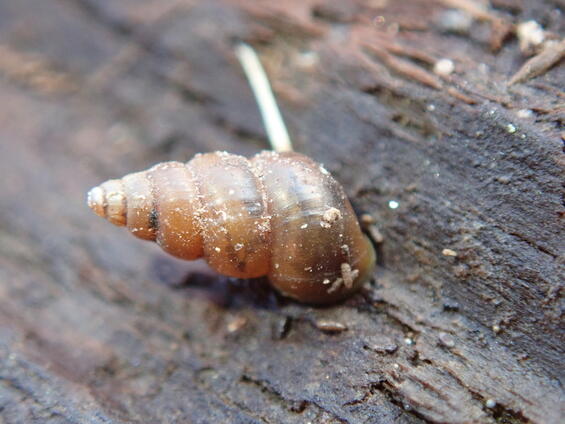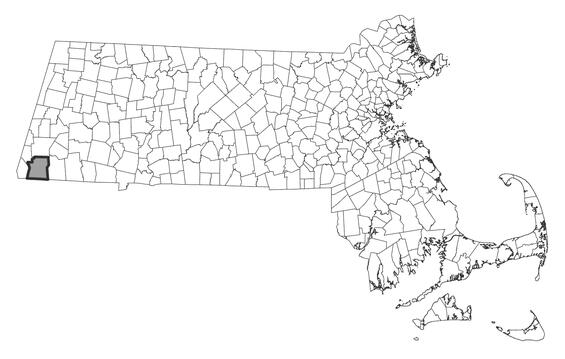- Scientific name: Pomatiopsis lapidaria
- Species of Greatest Conservation Need (MA State Wildlife Action Plan)
- Endangered (MA Endangered Species Act)
Description

A slender walker
The slender walker has an elongated conical shell that is dark brown to chestnut. It can reach up to 8 mm (.31 in) in length with 7 rounded whorls, separated by distinct sutures. The shell aperture (opening to shell cavity) is dextral (coiled to the right when facing observer) and has an operculum, a hardened circular structure that seals the shell. The slender walker’s operculum has a single obvious spiral, which fans out to the perimeter (paucispiral). The spiral shells of males usually have a higher number of whorls and tend to be more slender than females. Identification of this species can be difficult and can require knowledge of internal anatomical features.
The slender walker is quite similar to all snails in the family Hydrobiidae but attains a greater size, length, and higher conical shape. Identification guides sufficiently illustrate the differences among these species (Jokinen 1992, Smith 2000).
Life cycle and behavior
The life span for the slender walker is approximately 2.5 years (Dundee 1957). There are two reproductive periods between mid-March and October. Eggs are typically laid individually on moist soil at the water’s edge and are surrounded by a sandy husk made up of soil and fecal pellets. Young snails emerge after a few weeks by creating a hole in the egg capsule and husk to emerge. The young are seen throughout the summer in colonies ranging from a few dozen to many thousands of individuals.
If there is insufficient moisture, the snail will enter a dormant period with its operculum tightly closed. There are two major dormancy periods in the yearly cycle, winter and summer months, but neither period may be continuous. A few days of rain may provide enough moisture so that the snail becomes temporarily active again. This species may be found lying in vegetation and under objects during dormancy in the cold, winter months. In the hot, dry months of summer it can be found on the surface of the substrate. Given that the slender walker prefers shade and is found under cover on sunny days suggests that dormancy ensues somewhat immediately when there is lack of sufficient moisture (Dundee 1957).
Distribution and abundance
In Massachusetts, the slender walker is found in the upper Housatonic River drainage in Sheffield (Smith 1986). Elsewhere, this species has a spotty distribution of locally abundant individuals from Northern Florida north to southern Canada, and west through the Great Lakes into Minnesota and south into Arkansas.
Little is known regarding the population status of the slender walker in Massachusetts. In a 2002 field survey, the slender walker was locally abundant in one very distinct habitat along a stream where it is known to occur but was not found in any other area in that stream or in the adjacent wetland habitat of nearby streams (McLain 2003). The Slender walker is rarely encountered and is listed under the Massachusetts Endangered Species Act as Endangered. All listed species are protected from killing, collecting, possessing, or sale and from activities that would destroy habitat and thus directly or indirectly cause mortality or disrupt critical behaviors. In addition, listed animals are specifically protected from activities that disrupt nesting, breeding, feeding, or migration.

Distribution in Massachusetts. 2000-2025. Based on records in the Natural Heritage Database.
Habitat
The slender walker is found along riverbanks or in moist areas near streams in vegetation that is well protected from direct sunlight. While the Slender walker requires very moist conditions, it is not found submerged in water for long periods of time except during wet conditions, such as rain events. During these events, this species can be submerged for several days. On sunny days, the snail can be found under leaves in the shade whereas on cloudy days it may be easily visible. It is usually found on substrates that have a high proportion of sand and dead plant material. In Massachusetts, the slender walker has been found in the moist floodplain of Schenob Brook, a calcium rich, low gradient stream. Sensitive Fern (Onoclea sensibilis) dominates the area where snail colonies are found.
Healthy habitats are vital for supporting native wildlife and plants. Explore habitats and learn about conservation and restoration in Massachusetts.
Threats
Threats to slender walker include habitat degradation and loss from forest and understory clearing, trampling from human traffic, and alteration of streamflow (e.g., excessive flooding) from dams or climate change.
Conservation
Survey and monitoring
Surveys for slender walker are needed at its historical site and other tributaries to the Housatonic River. Monitoring efforts are recommended every 5 years or as needed (e.g., in response to potential disturbance events) to update its population status in Massachusetts.
Management
As with many rare species, the exact management needs for the species are unknown. However, the protection of slender walker habitat is critical for species persistence in Massachusetts. Efforts to minimize herbicide runoff, habitat trampling, or other non-target species impacts from invasive plant management activities is required in slender walker habitat.
Research needs
The population status of slender walker remains uncertain in Massachusetts. Surveys targeting historical and new sites are needed to better understand its distribution and habitat requirements. Furthermore, habitat conditions, such as air temperature and relative humidity thresholds, that trigger active (reproductive) and dormant periods are unknown in Massachusetts and may inform overlapping management actions. Slender walker risk assessment to extreme or frequent flooding events is needed and may be impacted by climate change.
References
Dundee, D.S. 1957. Aspects of the biology of Pomatiopsis lapidaria (Say) (Mollusca: Gastropoda: Prosobranchia). Misc. Publ. Mus. Zool. Univ. Michigan. No. 100:1-37, 16 pls.
McLain, D. 2003. Status of 4 state-listed snails in western Massachusetts in 2002. A report to the Massachusetts Natural Heritage and Endangered Species Program.
Jokinen, E.H. The Freshwater Snails (Mollusca:Gastropoda) of New York State. New York State Museum Bulletin 492, 1992.
Smith, D.G. 2000. Keys to the freshwater macroinvertebrates of southern New England. Published by author. Sunderland, MA. 243pp.
Smith, D.G. 1986. The rediscovery of Pomatiopsis lapidaria (Say) in New England. Malacological Review 19: 115-116.
Contact
| Date published: | April 11, 2025 |
|---|